This month sees the centenary of the Battle of Arras which took place from the 9th of April to the 16th of May 1917. This was a major offensive involving troops from the four corners of the British Empire who attacked trenches held by the army of Imperial Germany to the east of the city of Arras, France.
It was planned in co-operation with the French and to coincide with their forthcoming offensive on the German positions topping the Chemin-des-Dames ridge, an area of high ground north west of Rheims.
The Commonwealth War Graves Commission (CWGC) website states that in 38 days of fighting around Arras, some 300,000 servicemen on both sides were wounded, missing or dead. The British Army suffered an average of 4,000 wounded and killed every day: the highest average daily casualty rate of any British offensive on the Western Front. For many, the combat they experienced at Arras would be the most brutal of the war.
Not only ground troops were involved – the CWGC website continues – in April 1917, the Royal Flying Corps (RFC) fought for control of the skies above Arras. The losses they suffered were so heavy that the period became known to British aircrews as ‘Bloody April’. After the war, this location was chosen for the memorial to all those flyers of the British Empire who died on the Western Front but whose final resting place is unknown. The RFC had the vital role of scouting enemy positions, directing the fire of British artillery, and attacking enemy positions and troops. They outnumbered the Germans but their aircraft were old and almost obsolete. Using superior technology and tactics the Germans inflicted terrible losses on their RFC counterparts. Manfred Von Richthofen – better known as the ‘Red Baron’ claimed over 20 ‘kills’ during April alone.
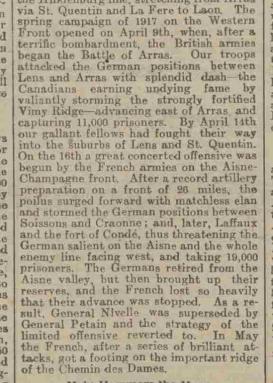 The article alongside is part of a summary of the progress of the War printed in the North Devon Journal in the January of 1918. Throughout the War there appear weekly updates on the campaigns in the various theatres of war as well as news of North Devon soldiers, both on the front and at home. One such weekly update, published on Thursday 10th May and written on the Friday of the previous week, is reproduced below.
The article alongside is part of a summary of the progress of the War printed in the North Devon Journal in the January of 1918. Throughout the War there appear weekly updates on the campaigns in the various theatres of war as well as news of North Devon soldiers, both on the front and at home. One such weekly update, published on Thursday 10th May and written on the Friday of the previous week, is reproduced below.
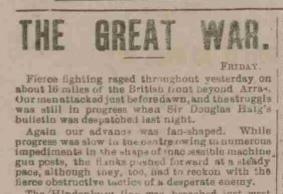
One casualty of the battle, Herbert Eller, has already featured in one of our earlier blogs. The letters that he wrote to his mother from the Front, including many first hand experiences, were published in the North Devon Journal. His story is particularly poignant as he had a German father, and you can read it by clicking here Herbert Eller 1891-1917 Private 13180 2nd Battalion Devonshire Regiment Arras
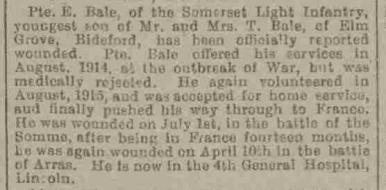
More fortunate, and now safely returned to Blighty, was Bideford soldier Private E Bale who had been wounded at the Somme and again during the battle for Arras. As he is not mentioned on the town memorial, he appears to have survived the war.
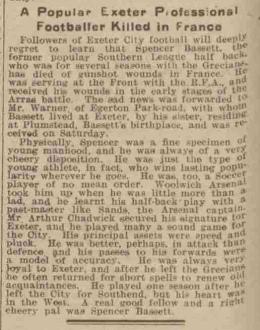
Local football fans and, in particular, supporters of Exeter City FC would have been saddened to read of the death of Spencer Bassett, a half back who had played for Arsenal.
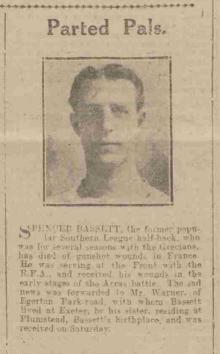
These reports appeared in the Western Times, where he was described as “a real good fellow and a right cheery pal”.
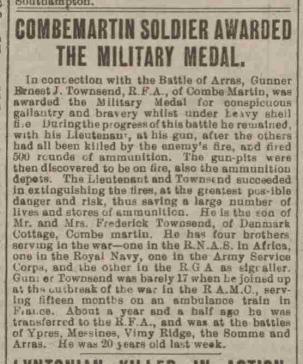
In August 1917 it was announced in the North Devon Journal that young Ernest Townsend of Combe Martin had been awarded the Military Medal for his conspicuous gallantry and bravery during the battle.
Aged only 20 he had already served three years on the front line.
Again, as he does not appear on the village memorial, he appears to have survived the war.
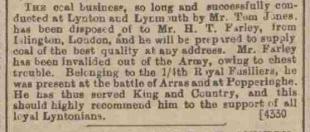 This article, from November 1917, almost asks for acceptance of an “incomer” to Lynton taking over a local coal business, on the grounds that he has served his country at Arras and Popperinghe.
This article, from November 1917, almost asks for acceptance of an “incomer” to Lynton taking over a local coal business, on the grounds that he has served his country at Arras and Popperinghe.
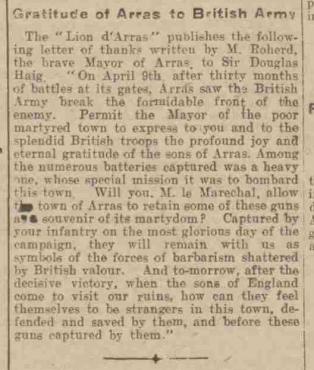
The Western Times published the thanks of the people of Arras to the British Army on the 19th of May 1917. Arras is a major place of commemoration of the war and, although I have not been able to find whether the guns mentioned still exist, is where a huge memorial and cemetery designed by Sir Edwin Lutyens can be found. More about WW1 memorials in and around Arras
Download Commonwealth War Graves Commission Arras Guide
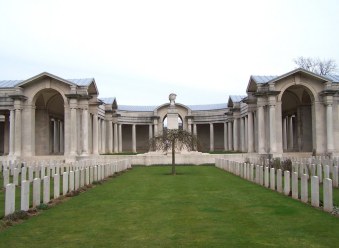
Despite the up to date reports appearing in the local press there were times where, due to the nature of the ongoing campaign, news of specific casualties was delayed substantially, which must have caused their loved ones much anxiety and distress.
It was not until nearly a year after the event that the death of Private Lawrence Couch of St Giles in the Wood could be confirmed to his wife and parents.

Also a year later the North Devon Journal could report the award of a crucifix in memory of those of the parish who had died in the War to Horwood Church. This was made from a shell, machine gun bullets and shrapnel.
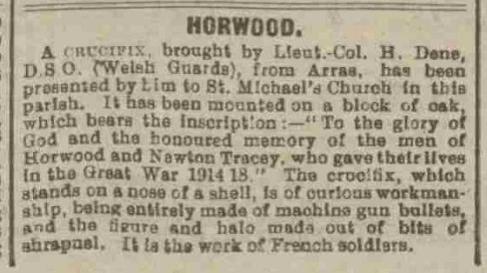
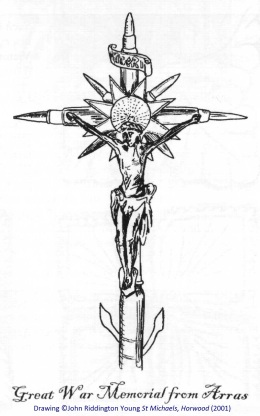
The crucifix may still be found in the church, recorded here by John Riddington Young in his 2001 booklet St Michael’s, Horwood.
Sources
Commonwealth War Graves Commission – Click here for website
British Newspaper Archive – North Devon Journal, Western Times (online – available free in the Local Studies Centre, charge for printouts)
St Michael’s, Horwood – John Riddington Young (2001) Reference copy available in the Local Studies Centre, Barnstaple
DG